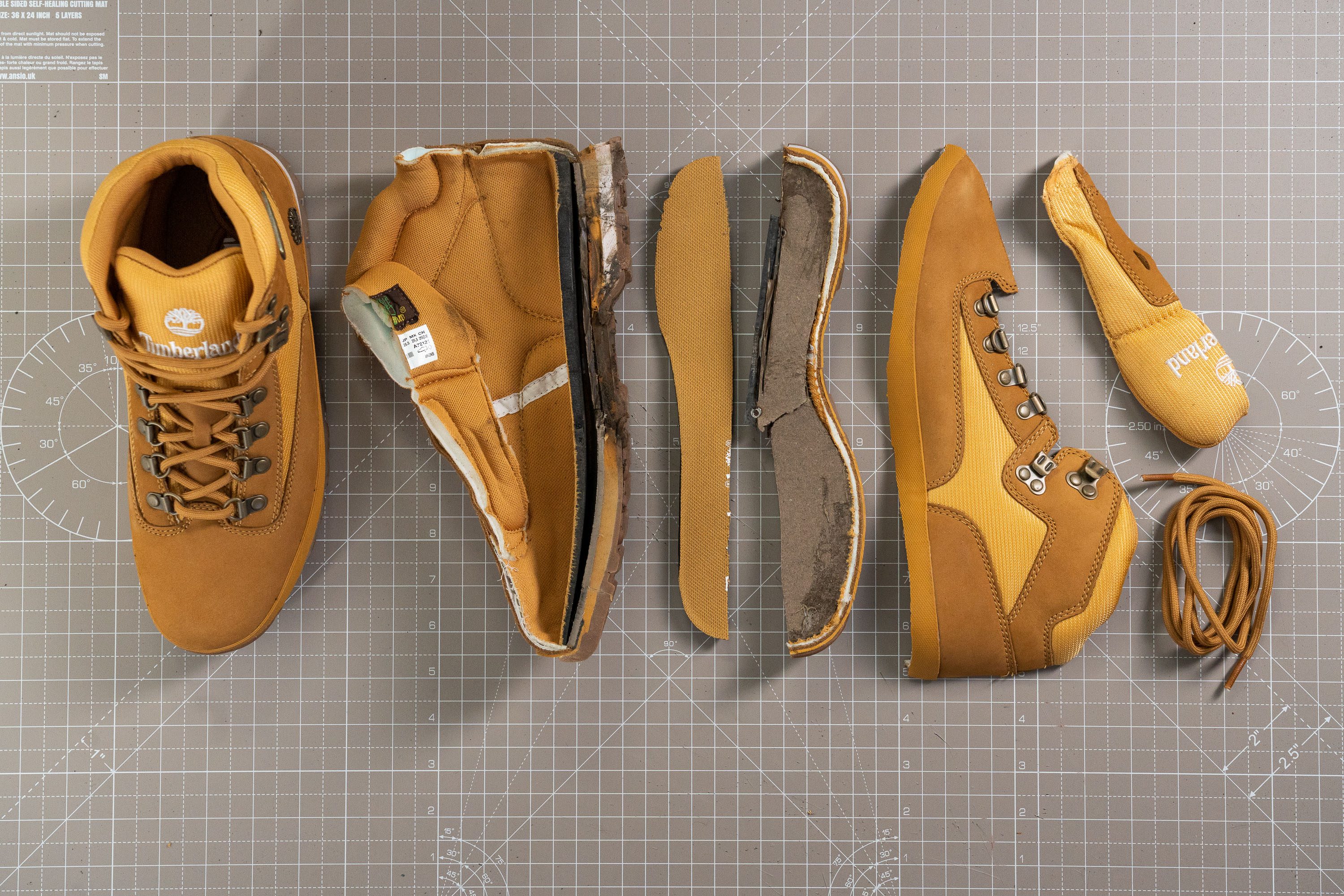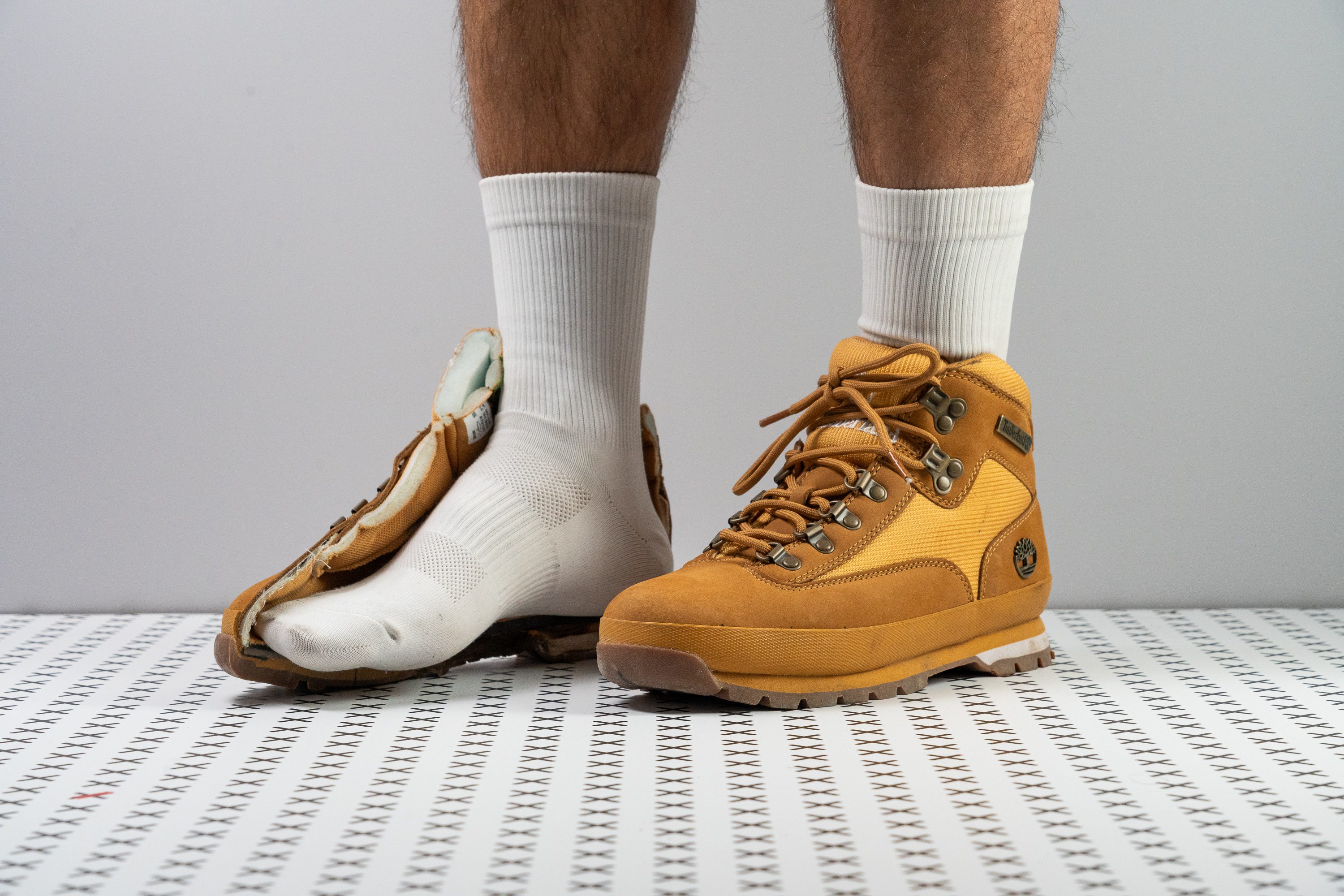Our verdict
- Top pick in best cheap hiking boots
Pros
- Amazing in-shoe comfort
- Insanely lightweight
- Supportive arch
- Lasting construction
- Above-average traction
- Recycled rubber used
- Attractive design
- Affordable
Cons
- Subpar ventilation
- Unruly laces
Audience verdict
- Top 25% most popular hiking boots
Comparison
The most similar hiking boots compared
+ + Add a shoe | |||||
|---|---|---|---|---|---|
| Audience score | 83 Good! | 90 Great! | 90 Great! | 87 Great! | |
| Price | $110 | $200 | $200 | $130 | |
| Trail terrain | Moderate | LightModerate | LightModerate | Light | |
| Shock absorption | Low | Low | High | Moderate | |
| Energy return | High | Low | High | Moderate | |
| Weight lab Weight brand | 18.1 oz / 513g 17.1 oz / 485g | 17 oz / 482g 17 oz / 482g | 15 oz / 425g 15 oz / 425g | 15.5 oz / 439g 15.7 oz / 444g | |
| Lightweight | ✗ | ✓ | ✓ | ✓ | |
| Breathability | Moderate | Warm | Breathable | Warm | |
| Use | Light HikingUrban hikingBeginners | Day HikingLight HikingUrban hiking | Day HikingSpeed HikingLight Hiking | Light HikingUrban hikingBeginners | |
| Orthotic friendly | ✓ | ✓ | ✓ | ✓ | |
| Drop lab | 14.0 mm | 13.5 mm | 14.4 mm | 12.3 mm | |
| Size | True to size | True to size | True to size | True to size | |
| Midsole softness | Firm | Firm | Soft | Soft | |
| Difference in midsole softness in cold | Small | Small | Big | Normal | |
| Heel counter stiffness | Flexible | Stiff | Flexible | Flexible | |
| Stiffness | Moderate | Moderate | Flexible | Flexible | |
| Outsole hardness | Soft | Very hard | Very soft | Average | |
| Waterproofing | - | Waterproof | - | Waterproof | |
| Material | Leather | Suede | KnitMesh | Textile | |
| Season | All seasons | Winter | SummerAll seasons | Winter | |
| Toebox durability | - | Decent | Decent | Bad | |
| Heel padding durability | - | Decent | Good | Decent | |
| Outsole durability | - | Decent | Good | Decent | |
| Width / fit | Narrow | Medium | Wide | Narrow | |
| Toebox width | Narrow | Medium | Medium | Narrow | |
| Lug depth | 3.4 mm | 3.7 mm | 3.7 mm | 3.0 mm | |
| Heel stack lab | 34.6 mm | 32.7 mm | 38.4 mm | 31.5 mm | |
| Forefoot | 20.6 mm | 19.2 mm | 24.0 mm | 19.2 mm | |
| Widths available | NormalWide | Normal | Normal | Normal | |
| Technology | Ortholite | Ortholite | - | - | |
| Cut | Mid cut | Mid cut | Mid cut | Mid cut | |
| Removable insole | ✓ | ✓ | ✓ | ✓ | |
| Ranking | #30 Bottom 26% | #8 Top 20% | #6 Top 15% | #17 Top 42% | |
| Popularity | #10 Top 25% | #32 Bottom 21% | #14 Top 35% | #28 Bottom 31% |
Cushioning
Shock absorption
The Euro Hiker is not a cushy boot for sure, and the fact that it features a metal shank doesn't make the underfoot experience any more forgiving.
We measured the boot's shock absorption at 72 SA, which is on the lower side of the spectrum and translates into a rather firm yet stable ride.
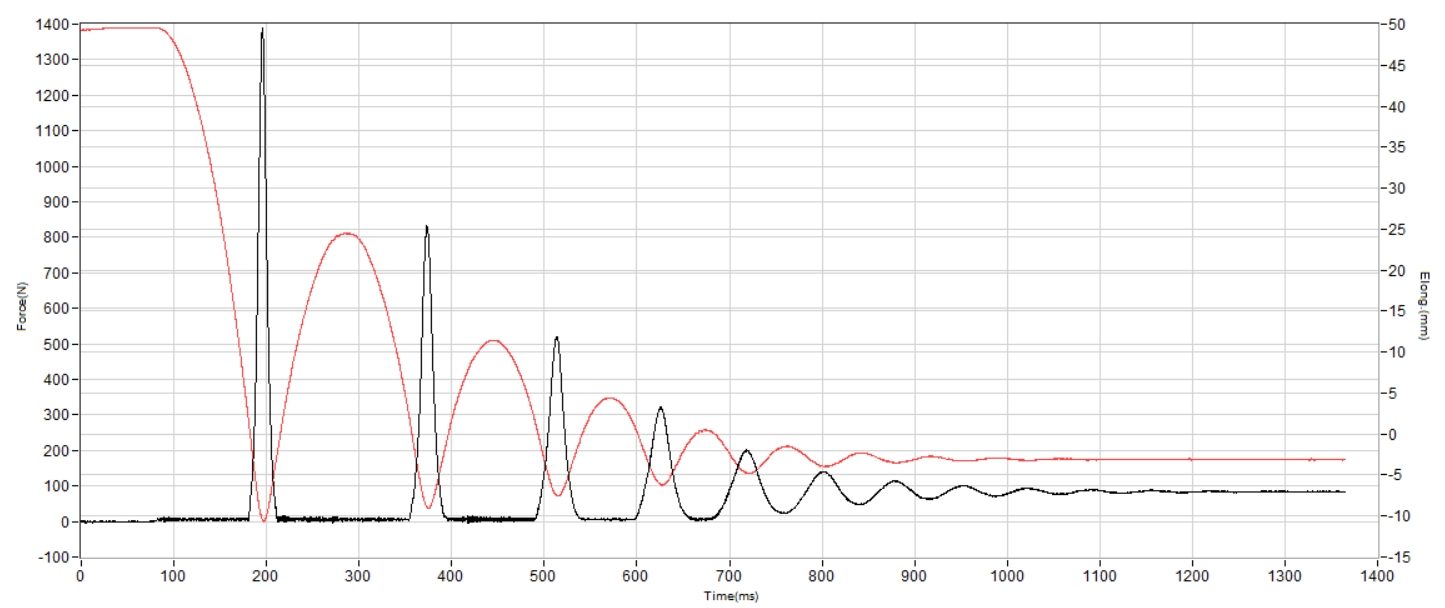
| Euro Hiker | 72 SA |
| Average | 93 SA |
Energy return
However, the shoe's midsole material proved to have some elasticity and showed a pretty high energy return of 55.8%. It adds some springiness to this Timberland boot's ride making it easier on the feet and body.
| Euro Hiker | 55.8% |
| Average | 50.5% |
Size and fit
Size
Timberland Euro Hiker fits true to size (56 votes).
Flexibility / Stiffness
We were utterly surprised to see some decent flexibility in the Euro Hiker's forefoot. But having cut the boot in half, we found that its metal shank doesn't extend to the forefoot.
So when we measured the boot's resistance to bending in a specialized flexibility tester, we found that it takes a moderate amount of force (29.7N) to bend by 30 degrees. This is about the same as it takes an average hiking boot.
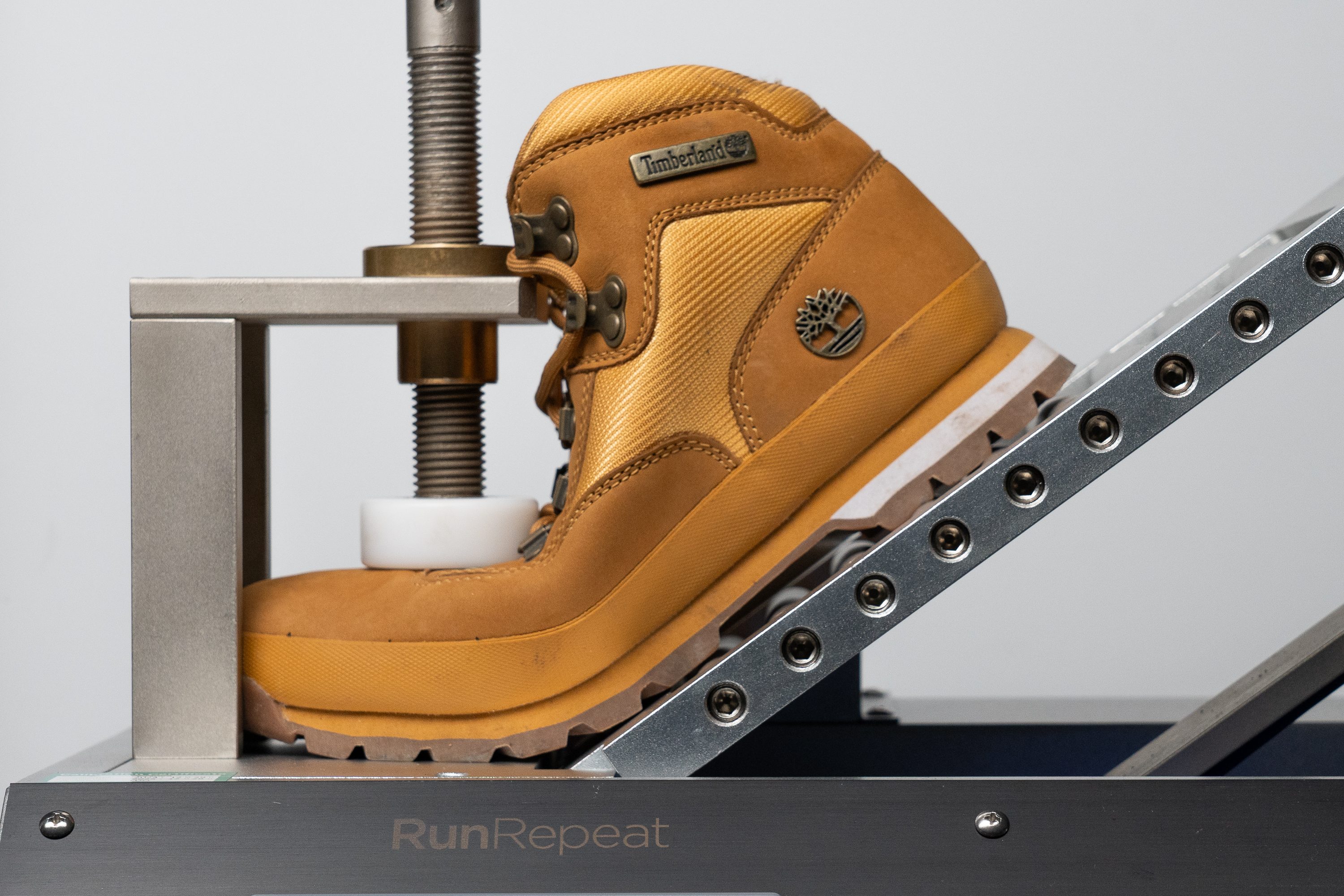
| Euro Hiker | 29.7N |
| Average | 31.5N |
Who should buy the Timberland Euro Hiker
A remarkable product in both form and function, the Euro Hiker delivers in full swing when the going gets tough without the hefty price tag. It is an excellent option for hikers who:
- tackle moderately rocky or muddy terrain
- are prone to arch fatigue (there is a supportive steel shank in the midsole)
- expect a lot of bumpy and abrasive hazards on the trail
- want a stylish pair of boots that can be worn around the city
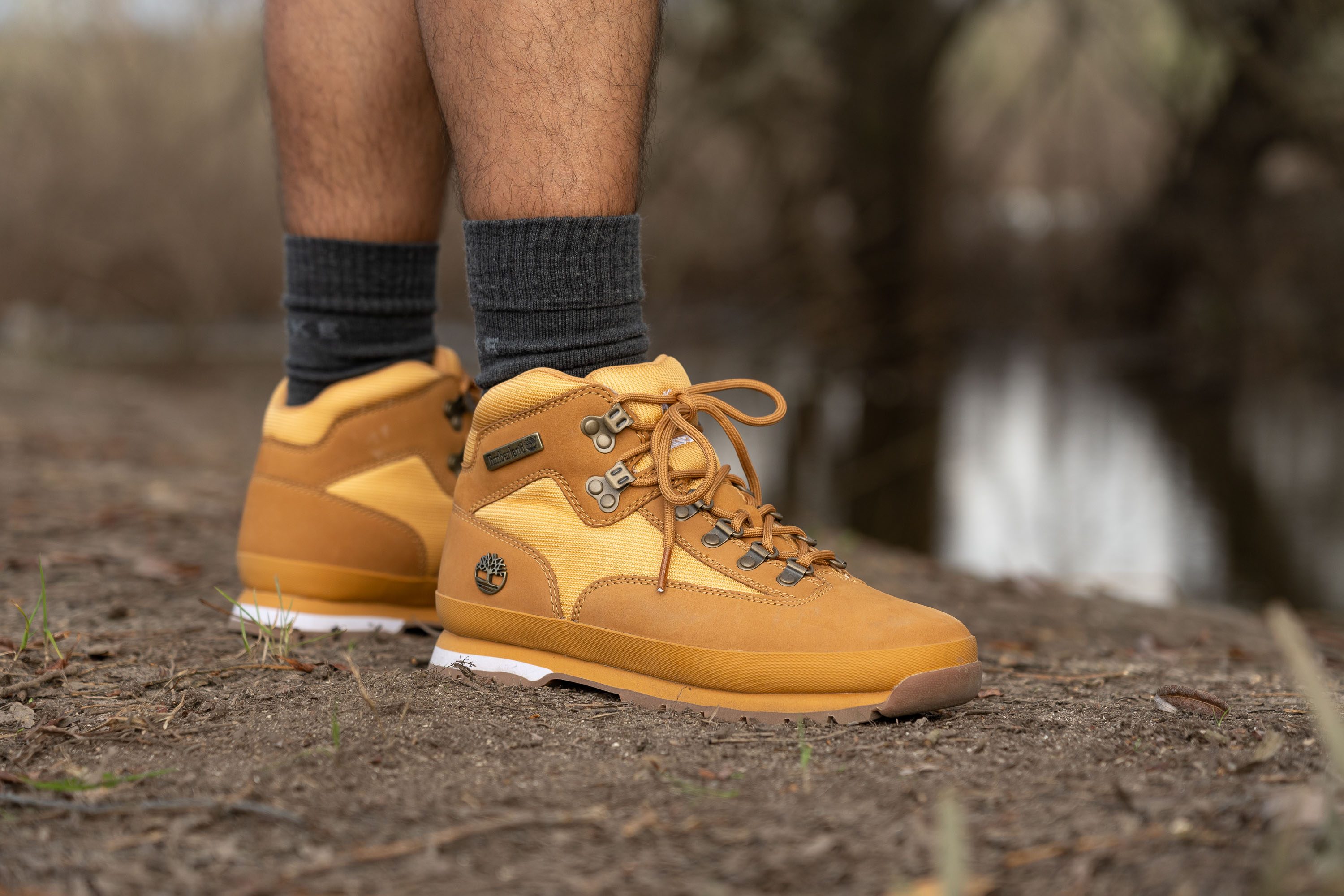
Who should NOT buy the boot
If your adventures take place mainly in puddly or rainy environments, we found the Hoka Trail Code GTX worth considering instead.
Also, if you want a hiking shoe that rocks when it comes to casual wear, we suggest looking at Columbia Fairbanks Mid.
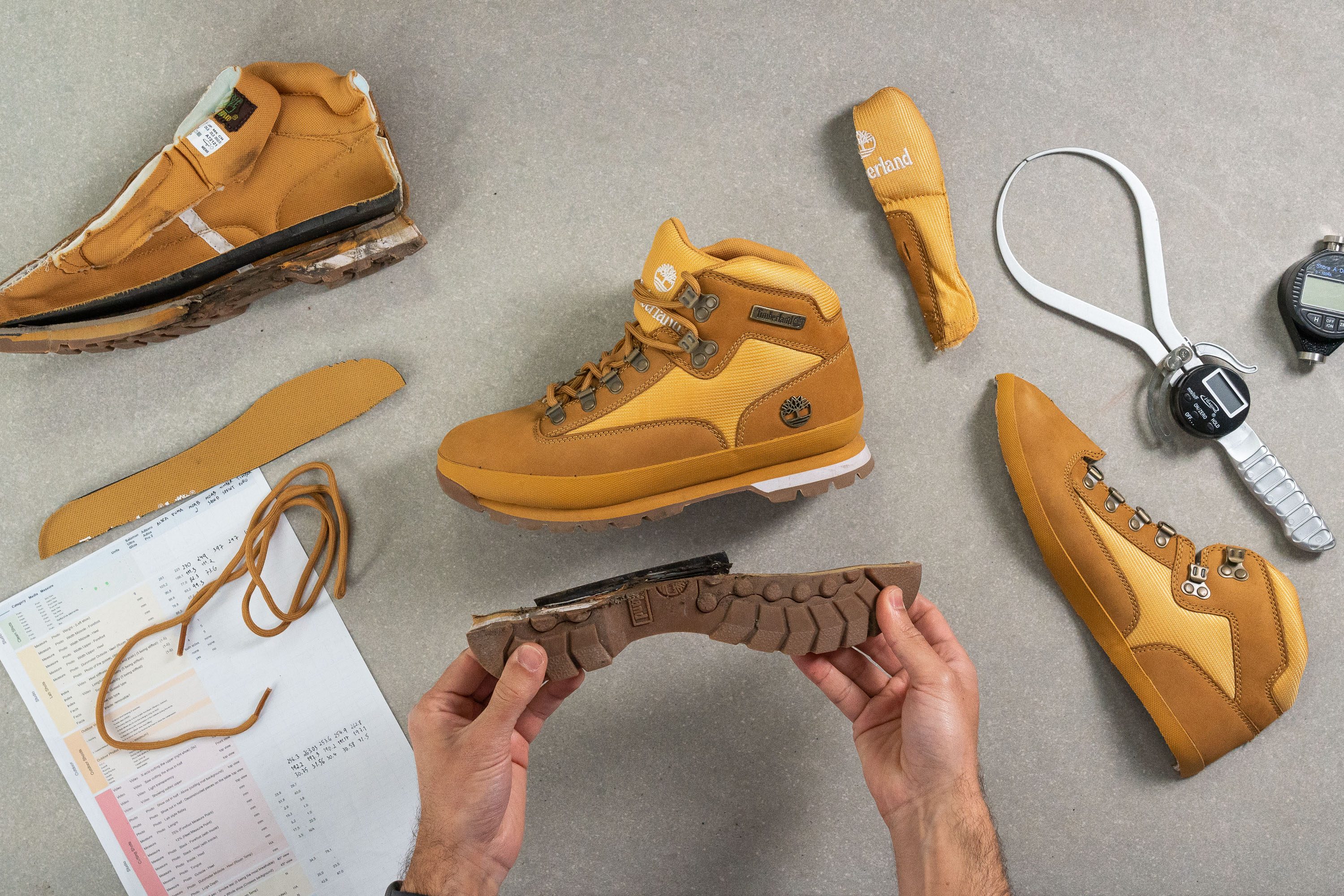
A lightweight wonder
Despite its rather beefy look, the Euro Hiker is astonishingly lightweight on our treks. After all, it weighs 485 g, which is about 70 g lighter than the average weight of hiking boots (558 g).
Not that breathable (but warm)
We do not consider this boot the ideal trail boot for hikes in warmer conditions.
Assessing the amount of smoke that escapes through the upper of the Euro Hiker, we rated it as 2 out of 5 (where 1 is the least breathable). Most Timberland boots in our catalog belong to the least breathable hiking boot options.
Putting the boot against a bright light, we can see that there are no ventilation pores throughout the upper.
On the bright side, we chose the Timberland Euro Hiker as our go-to fall and winter boot. We found that it is effective in keeping the foot warm as long as it's not freezing or pouring rain.
Timberland Euro Hiker: Cozy from top to bottom
This Timbs boot is mighty comfortable. Its generously padded collar and puffy tongue are the two culprits we found in this regard.
The heavily padded tongue is actually among the first things we noticed when first trying the boot on.
Measuring the tongue thickness with calipers, we found that it is a whopping 22.3 mm thick! For reference, the average for hiking footwear is 15.5 mm.
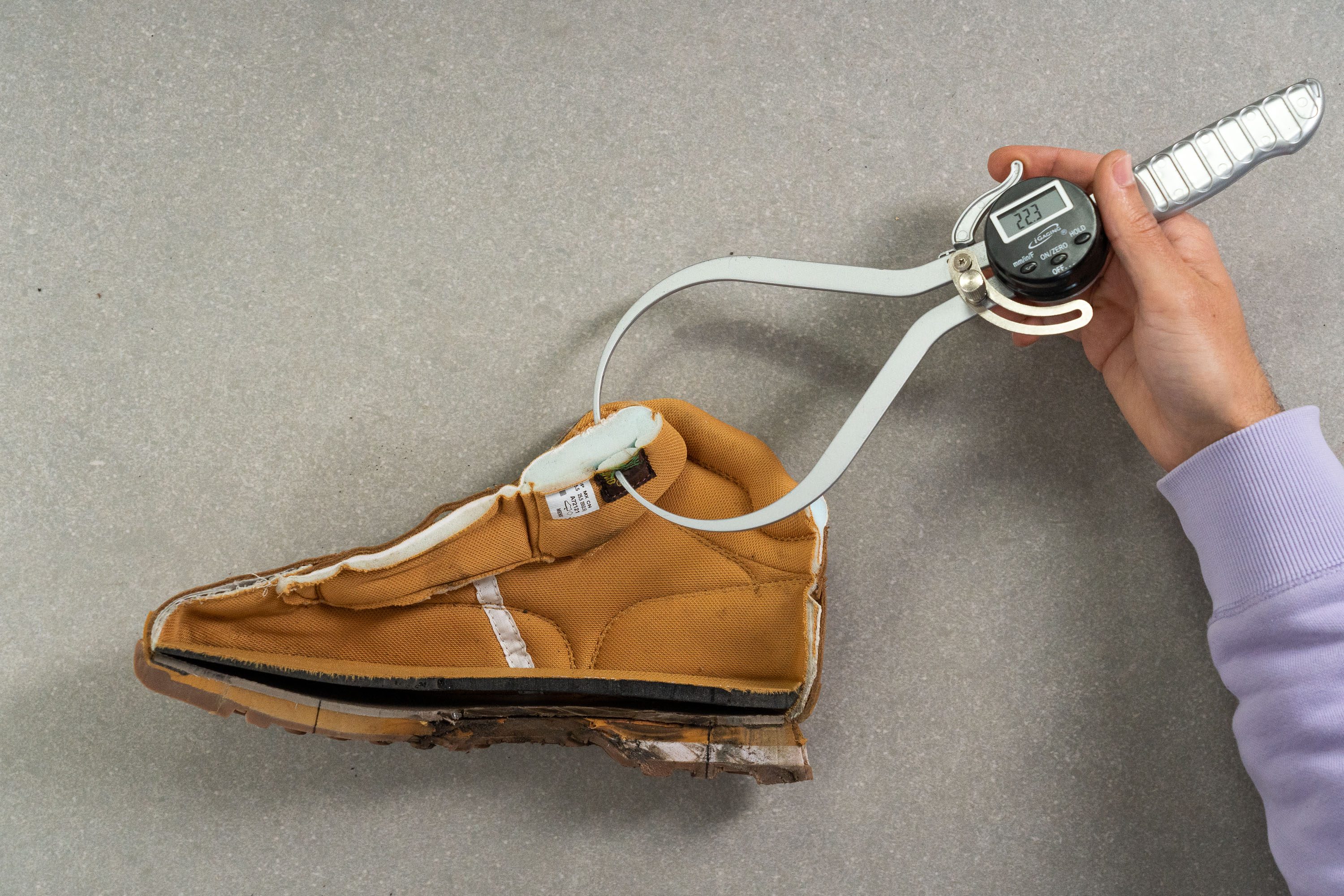
We thought that some might wish that the tongue was gusseted, as it used to be in the older iterations of the Euro Hiker.
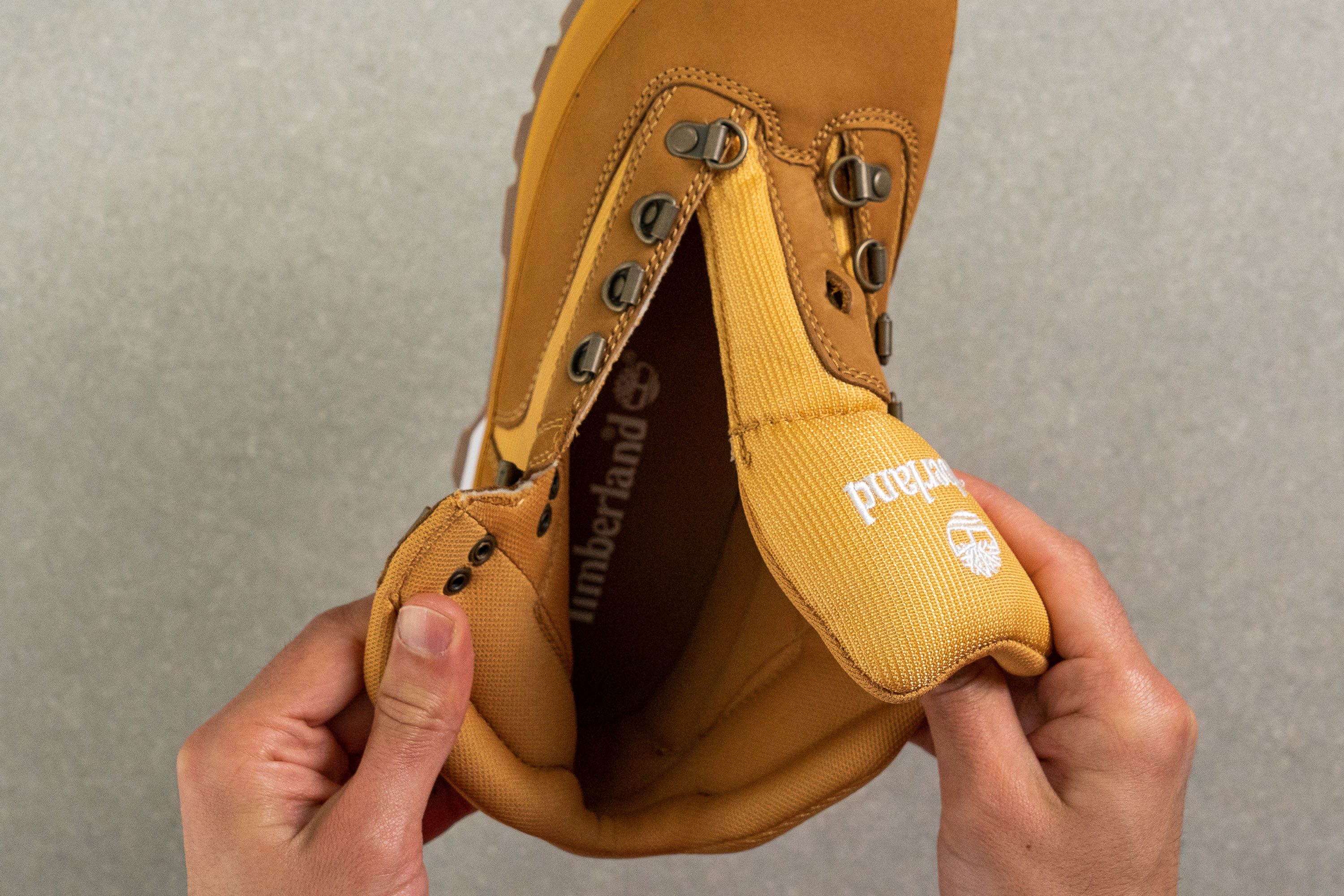
The collar is also very well-padded. And there is very little stiffness to it. On a 1-5 scale where 1 is the most flexible, we rated it as 2. It holds the heel and Achilles in place without being compressive.
All in all, this Timberland boot has built a reputation as one of the most comfortable options in its category. Some people have been buying this silhouette for more than 15 years!
Euro Hiker is easy to love at first sight
We adore the Euro Hiker for its eye-catching design.

This attractive hiking boot transitions seamlessly from the woods and mountains to make a fashion statement on the city streets. Bringing them on our trips, we realized that it is a compliment magnet.
Not to mention that it can be combined with anything, from an outdoor outfit to a pair of jeans.
Forget about rolling ankles
Euro Hiker also offers excellent stability for the ankles.
Delving into the boot, we learned it's equipped with a steel shank inside the midsole which prevents twisting of the foot.
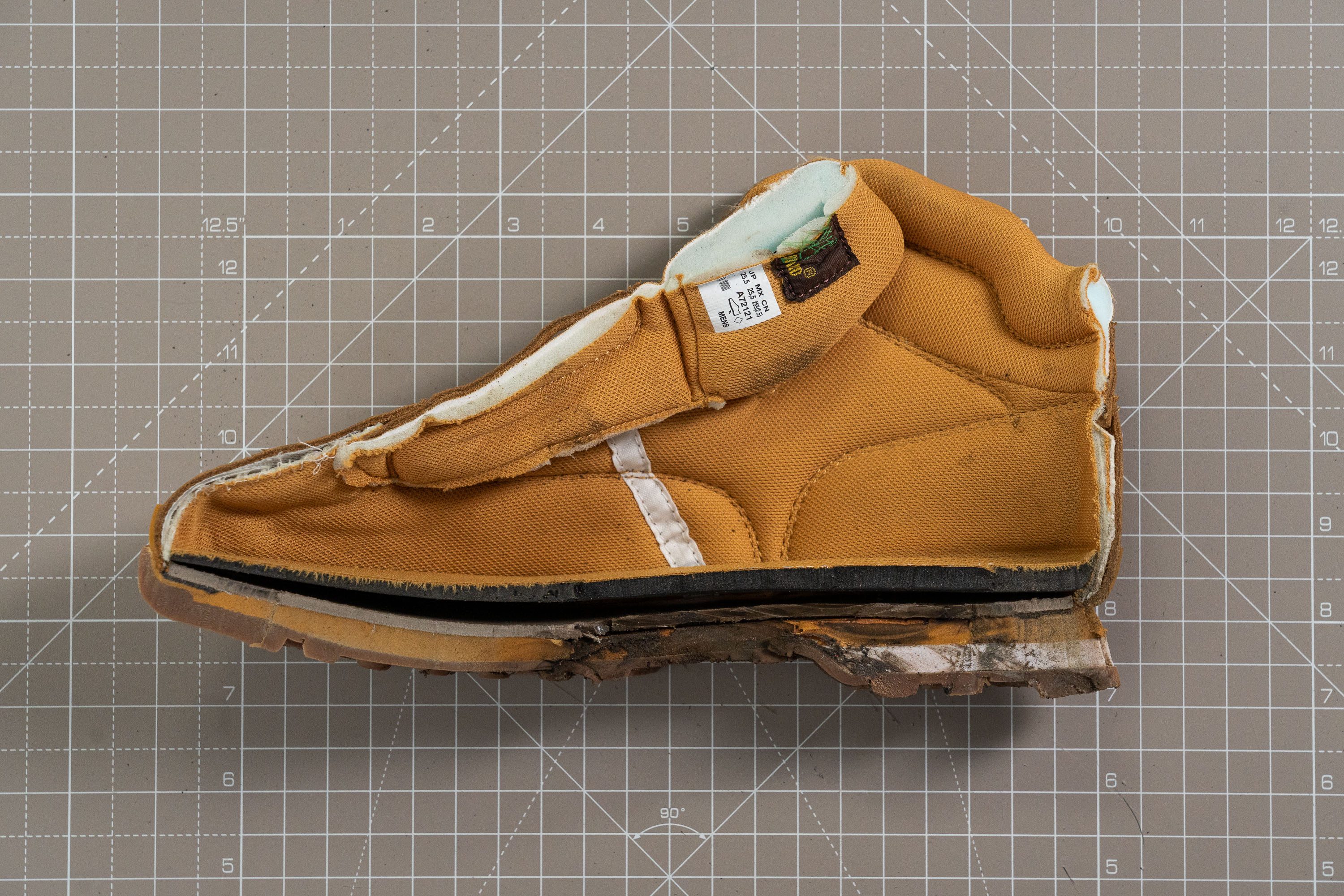
The shank contributes to the boot's torsional rigidity. On a 1 to 5 scale, where 5 is the stiffest, we rated this parameter of the Timberland Euro Hiker as 5.
The firm nature of cushioning on the Timberland Euro Hiker also eliminates underfoot squishiness which is typically associated with foot wobbling.
Sticking a durometer into the cushioning foam, we measured it to be 35%(!) firmer than the average. This is one of the firmest boots in our catalog.
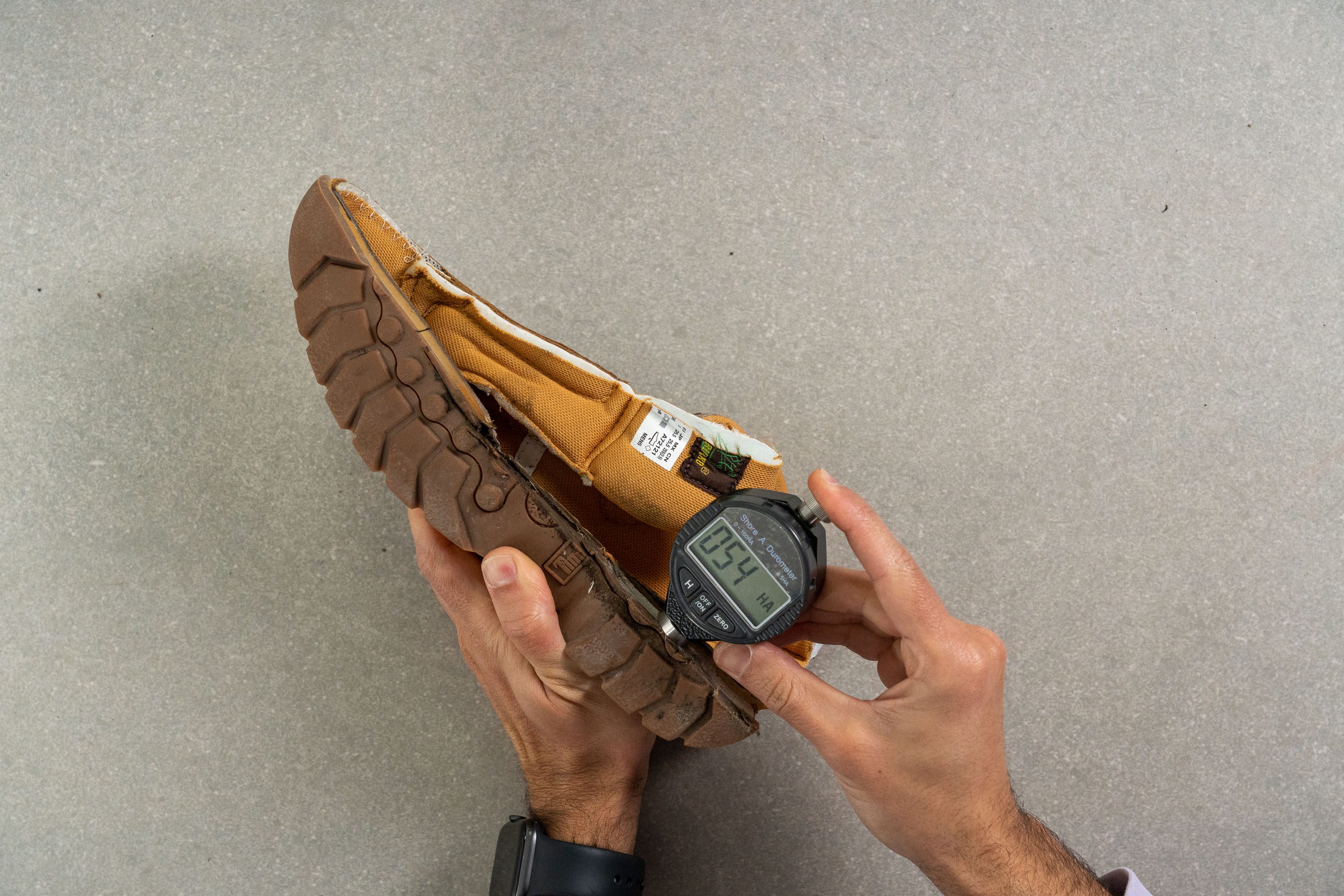
On the bright side, it doesn't get much firmer when exposed to low temperatures. After 20 minutes in the freezer, the midsole only got 7% firmer, whereas most boots get around 16% firmer.

All of these factors work together to help you feel planted and confident in each step.
Surprisingly, the sole is not so wide
A sense of stability is very often drawn from the width of the boot's sole. However, this is not the case with the Timberland Euro Hiker.
Based on our measurements, the Euro Hiker is considerably narrower than the average. In the widest part of the forefoot, our calipers show 96.3 mm (10.3 mm narrower than average).
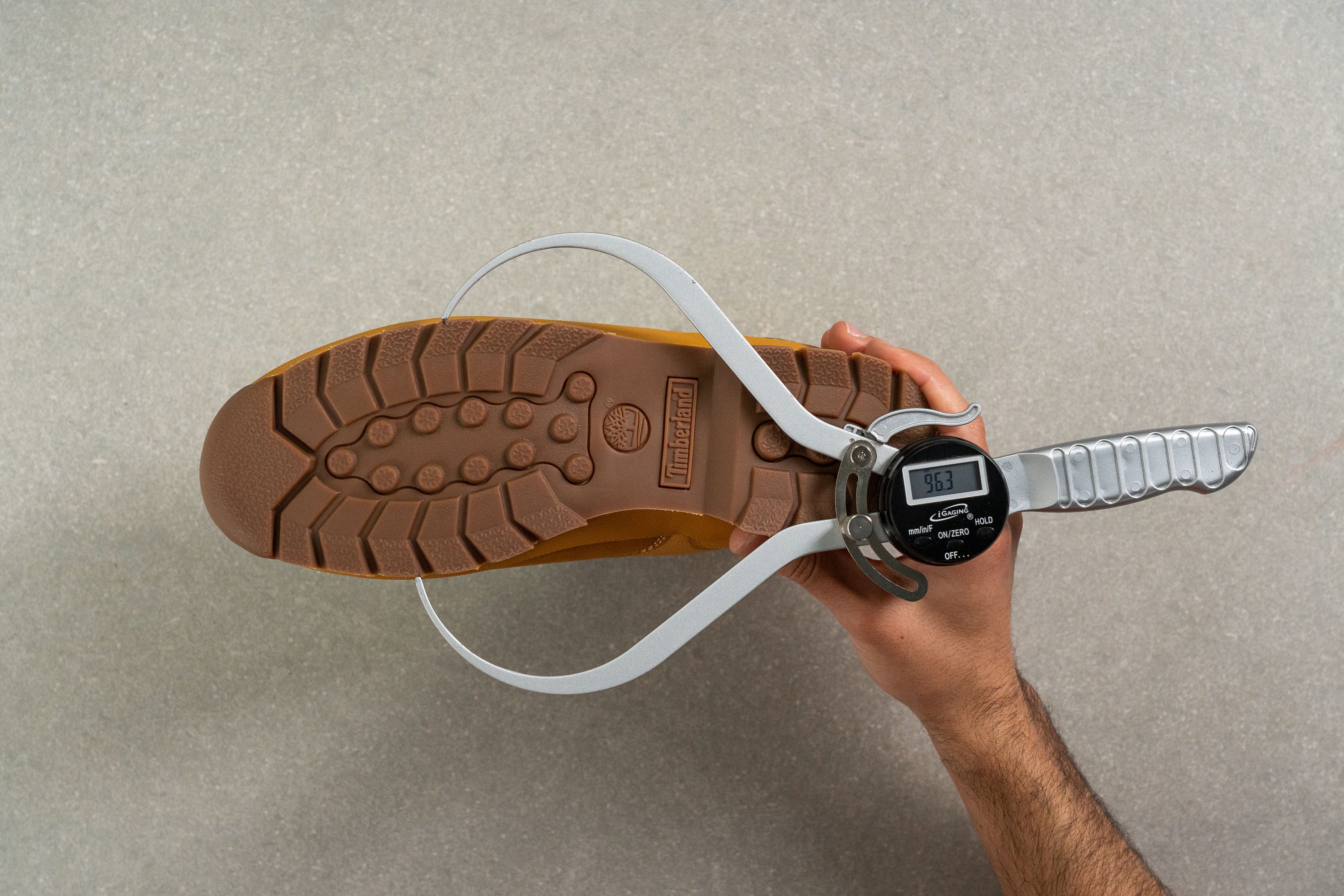
For context, here is the forefoot width of the Timberland Sprint Trekker (109.1 mm).

In the widest part of the heel, we found the Euro Hiker to be 71.7 mm (13.2 mm narrower than average).
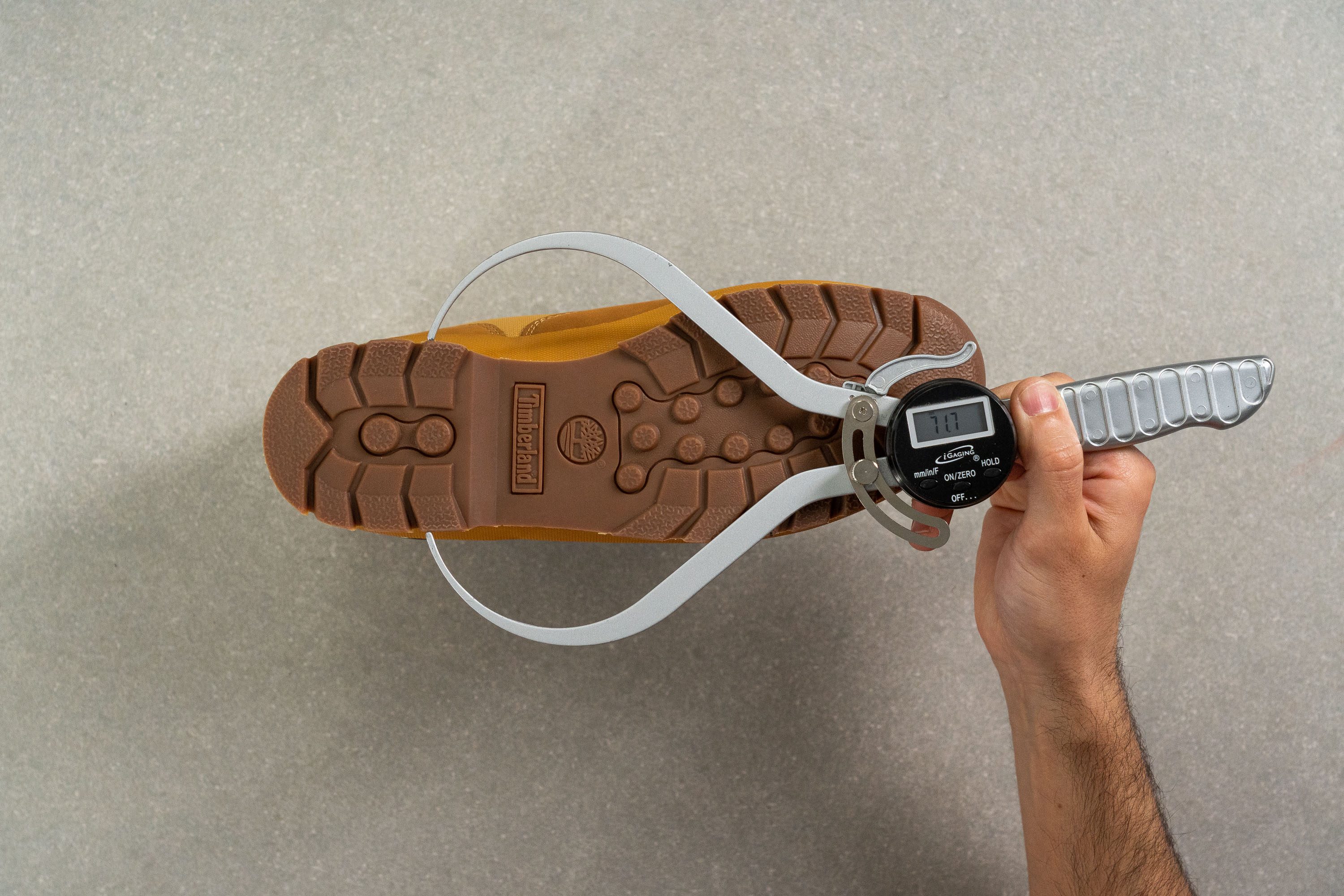
Stepping on rocks and debris is not a problem
Looking at the underfoot protection present in the Timberland Euro Hiker, you can rest assured that you've got the necessary buffer to keep your feet safe out there on the trail.
Based on our caliper measurements, the heel stack of the boot is 34.6 mm, nearly the same as the average 33.1 mm.
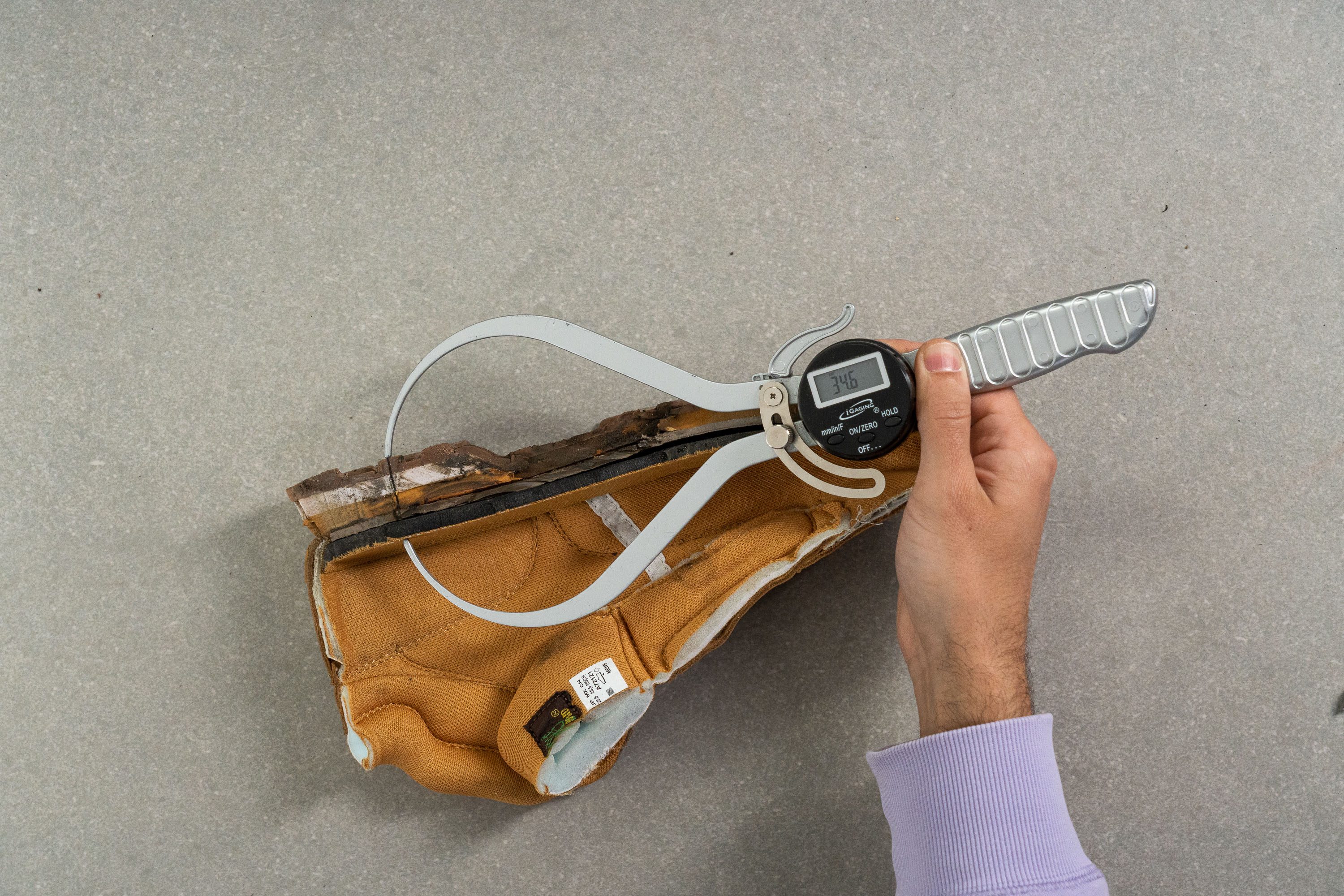
In the forefoot, it is 20.6 mm thick, also close to the average 20.8 mm.

In its heel section, the insole is 7.3 mm thick in the Timberland Euro Hiker. This is more cushioned than the average 5.8 mm.
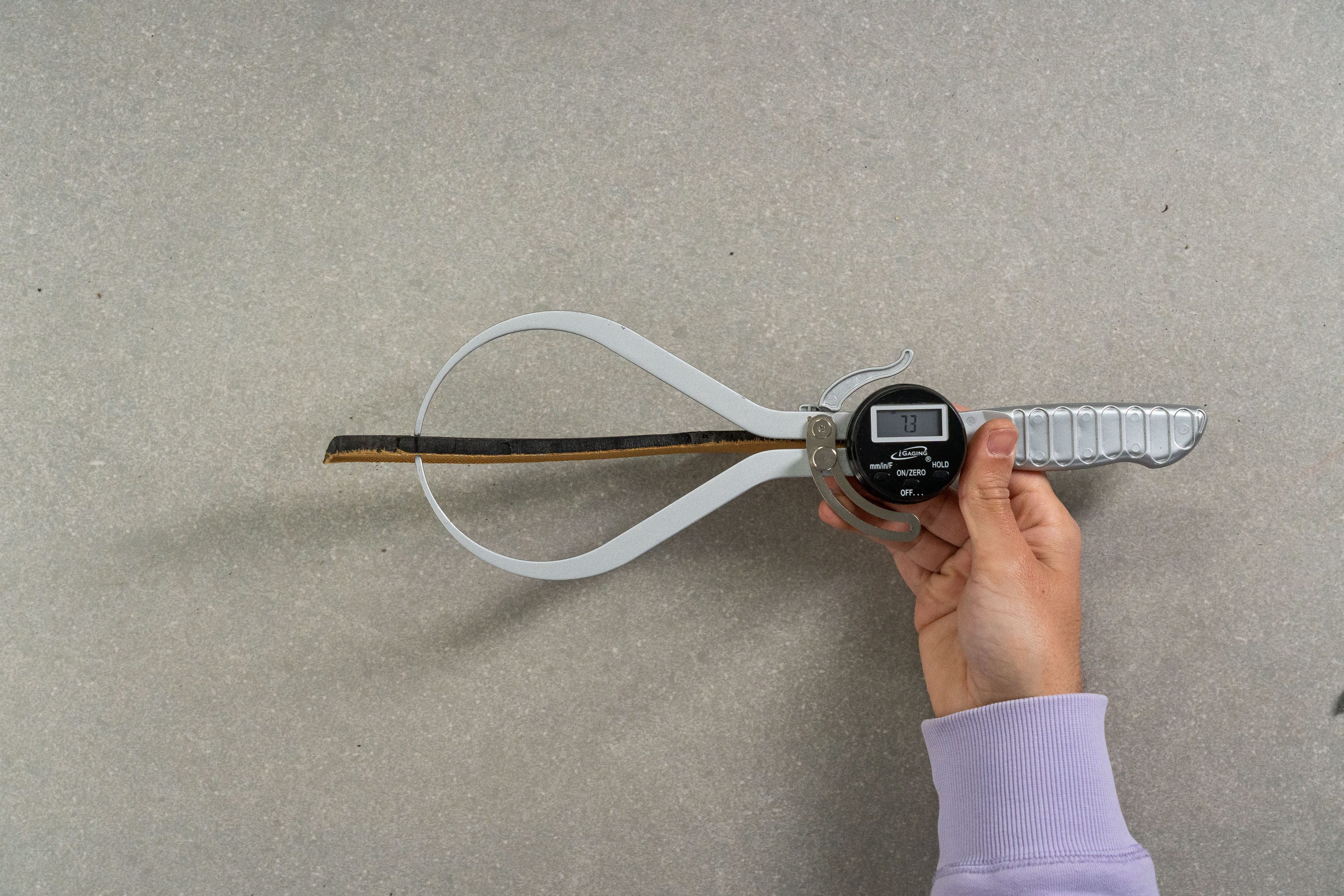
Grippy outsole of the Euro Hiker
The shoe's super-sticky outsole fascinated us. Not to mention that it is made with 34% recycled rubber.
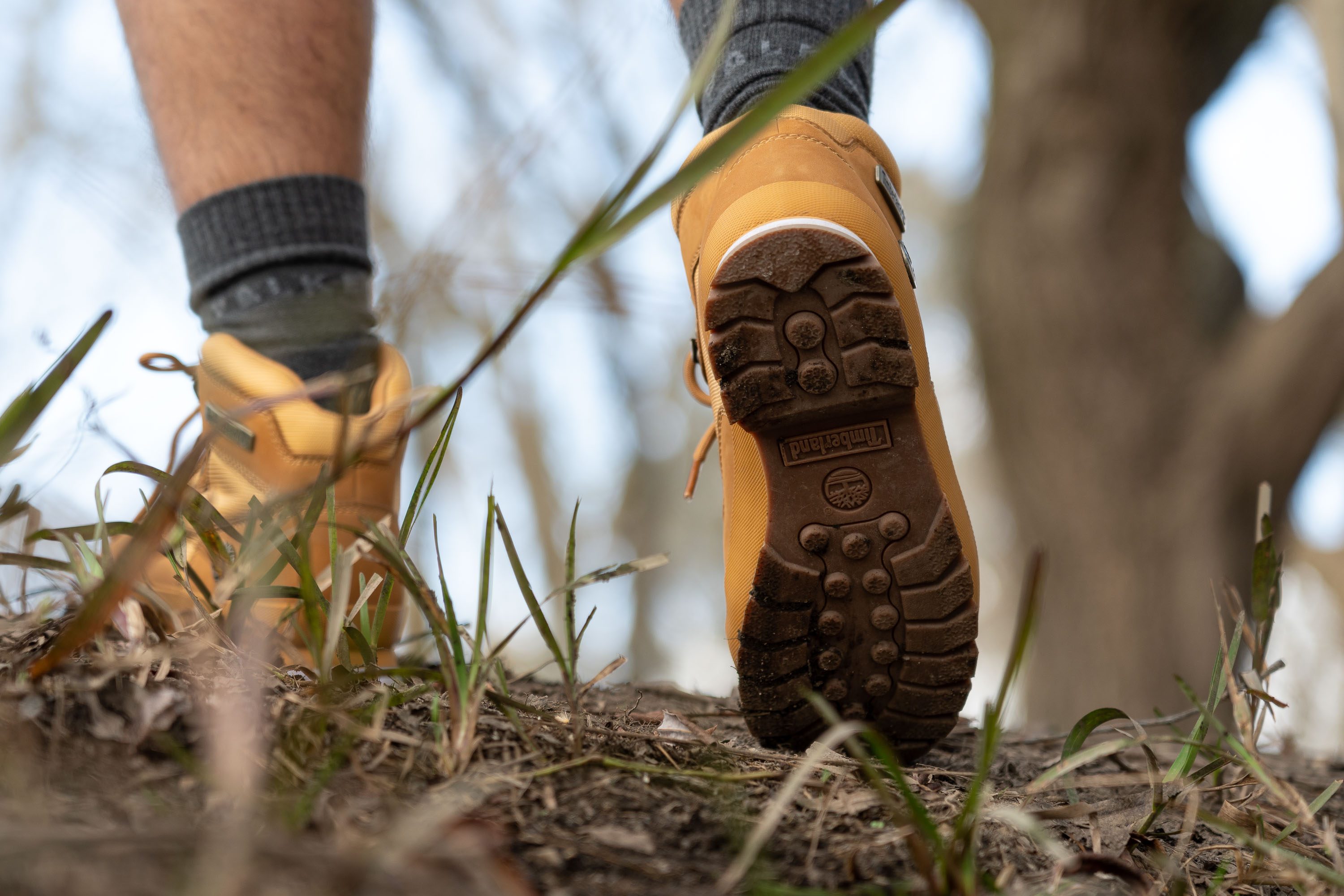
The lug depth on the Euro Hiker is 3.4 mm. This is shallower than the average 4 mm and makes the boot less suitable for muddy surfaces. Yet, this same characteristic makes it more suitable for urban conditions like paved roads.
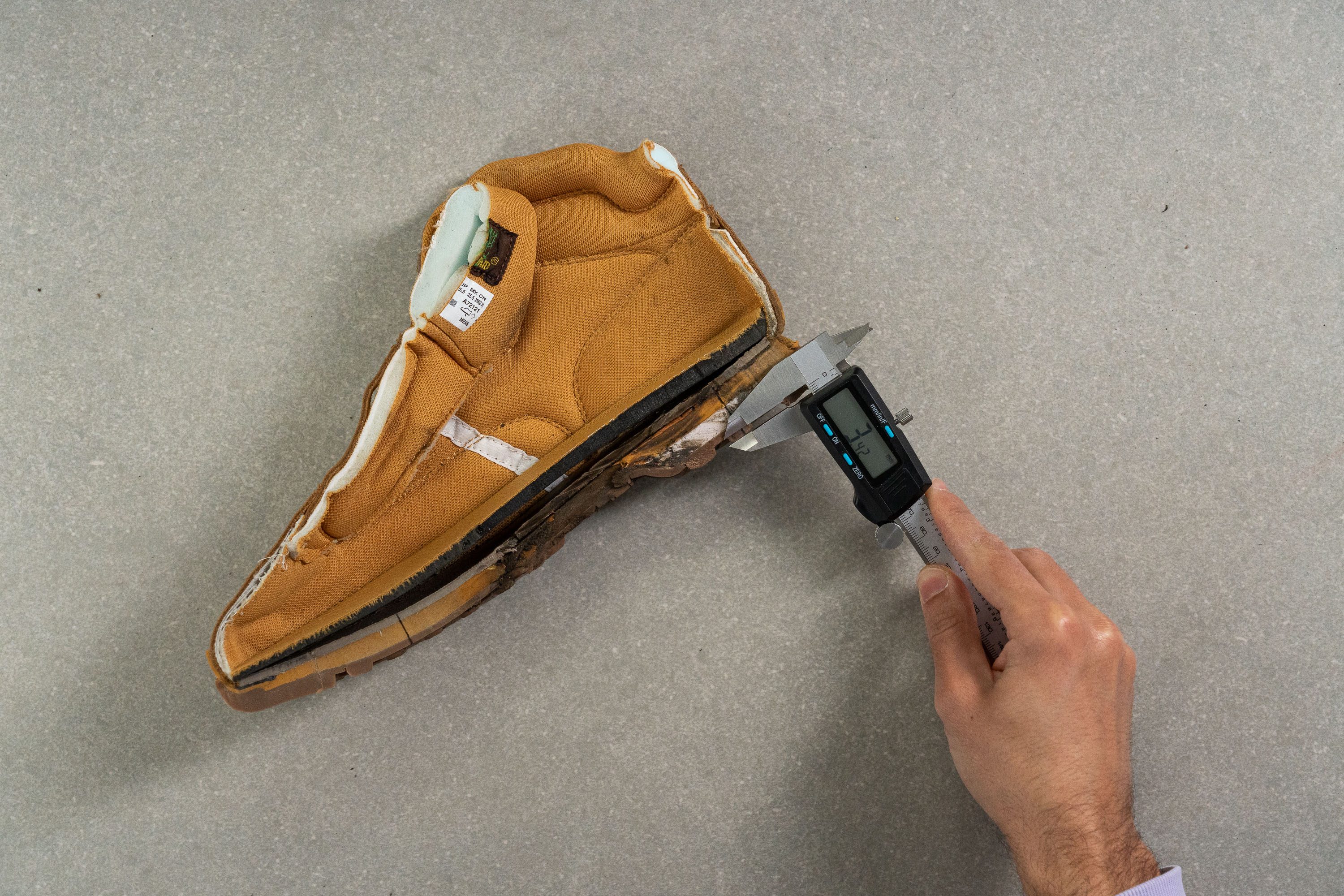
Durable but has room for improvement
We were satisfied with how much longevity we got from the pair of Euro Hikers. However, this Timberland is definitely not among the most durable boots out there.
We measured the outsole thickness at 3.5 mm. This is a solid result, considering that the average is 3.3 mm.
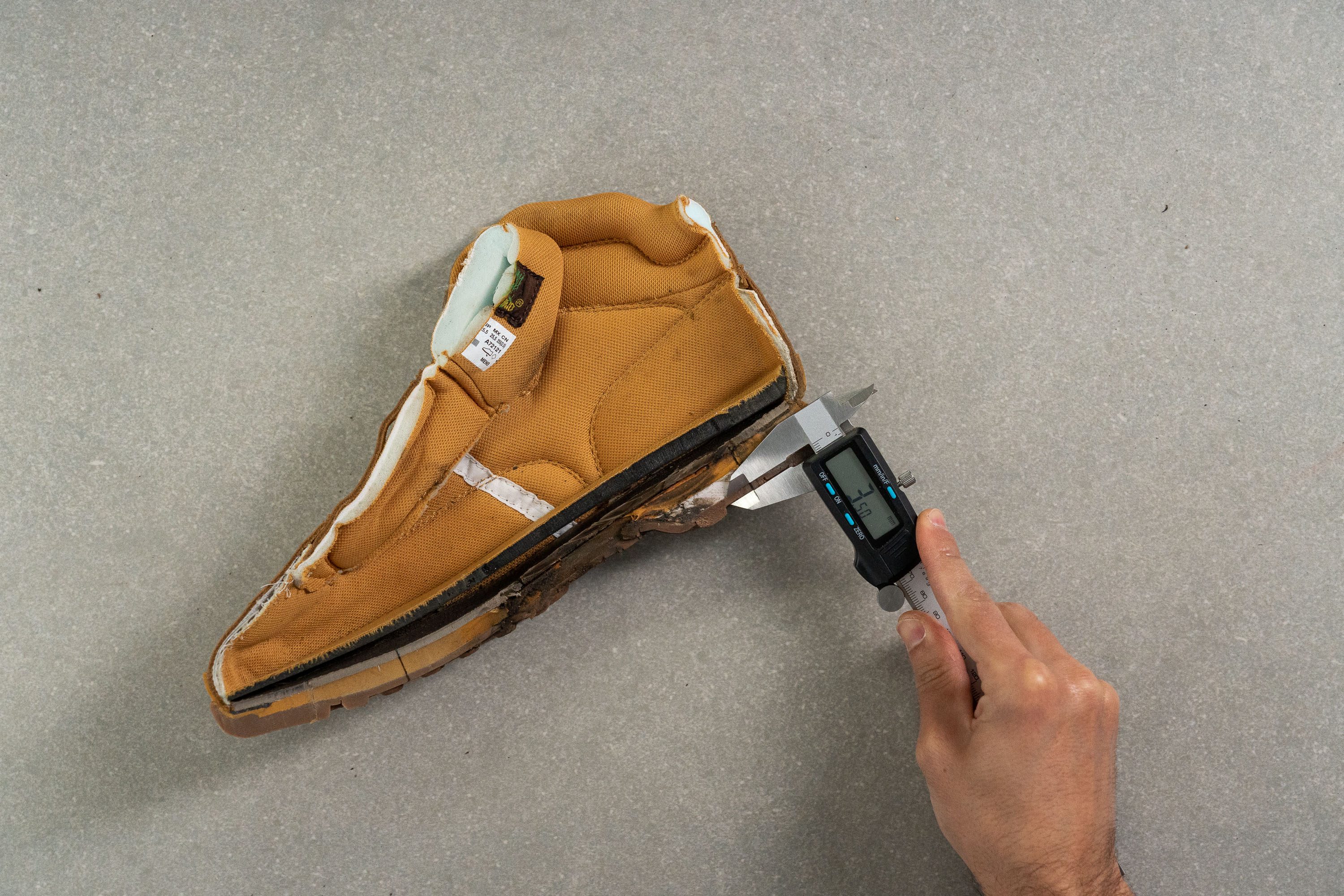
Meanwhile, the nature of this rubber is more on the soft side. Measuring the outsole with a durometer, we found that it is 3% softer than average.

Go true to size
We have no complaints regarding the fit or sizing of this hiking boot.
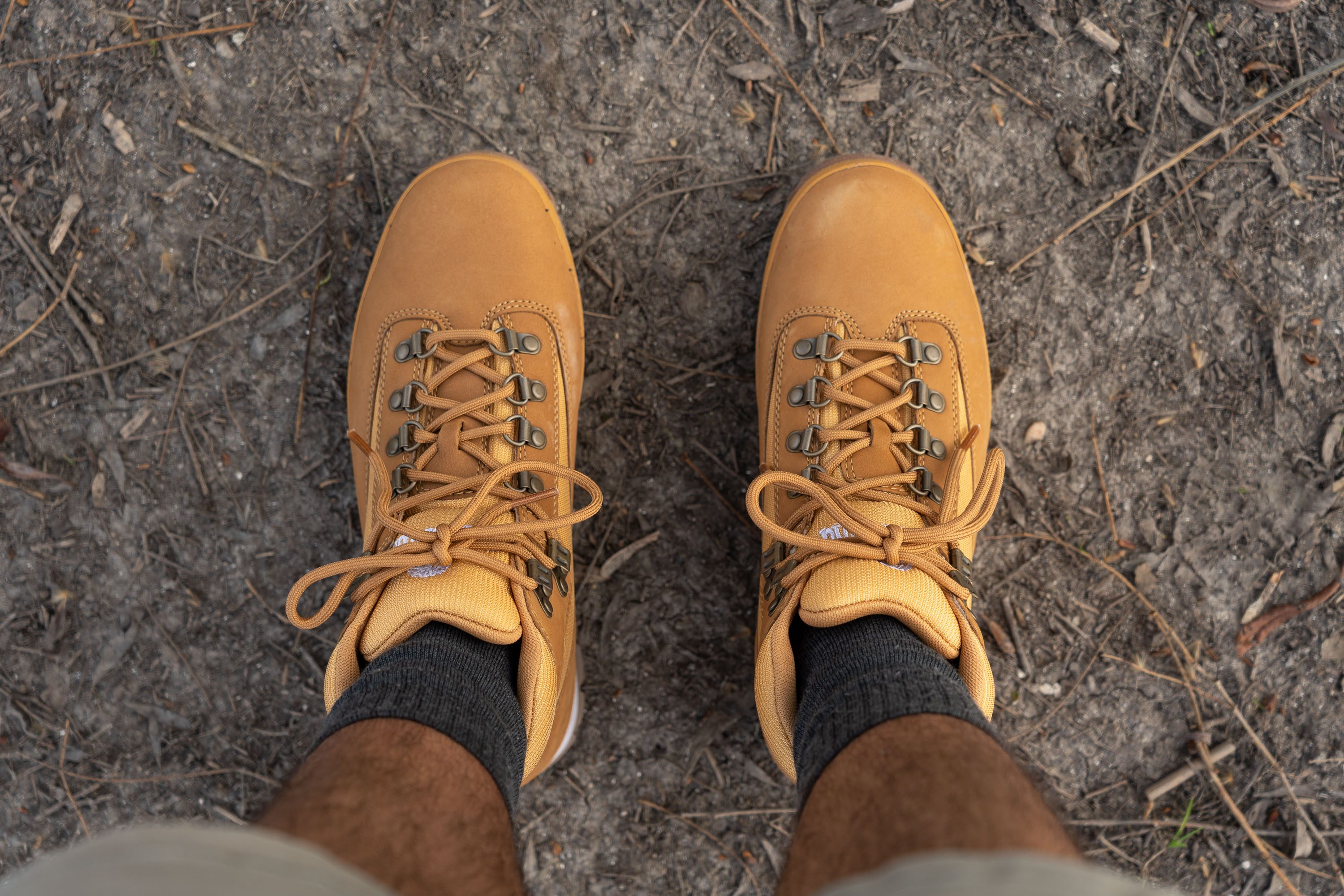
In a men's US size 7.5, we measured the internal length of the boot at 257.9 mm. Provided that there should be a few millimeters of extra space between your toes and the edge of the shoe, the Euro Hiker runs true to the Timberland footwear size chart.
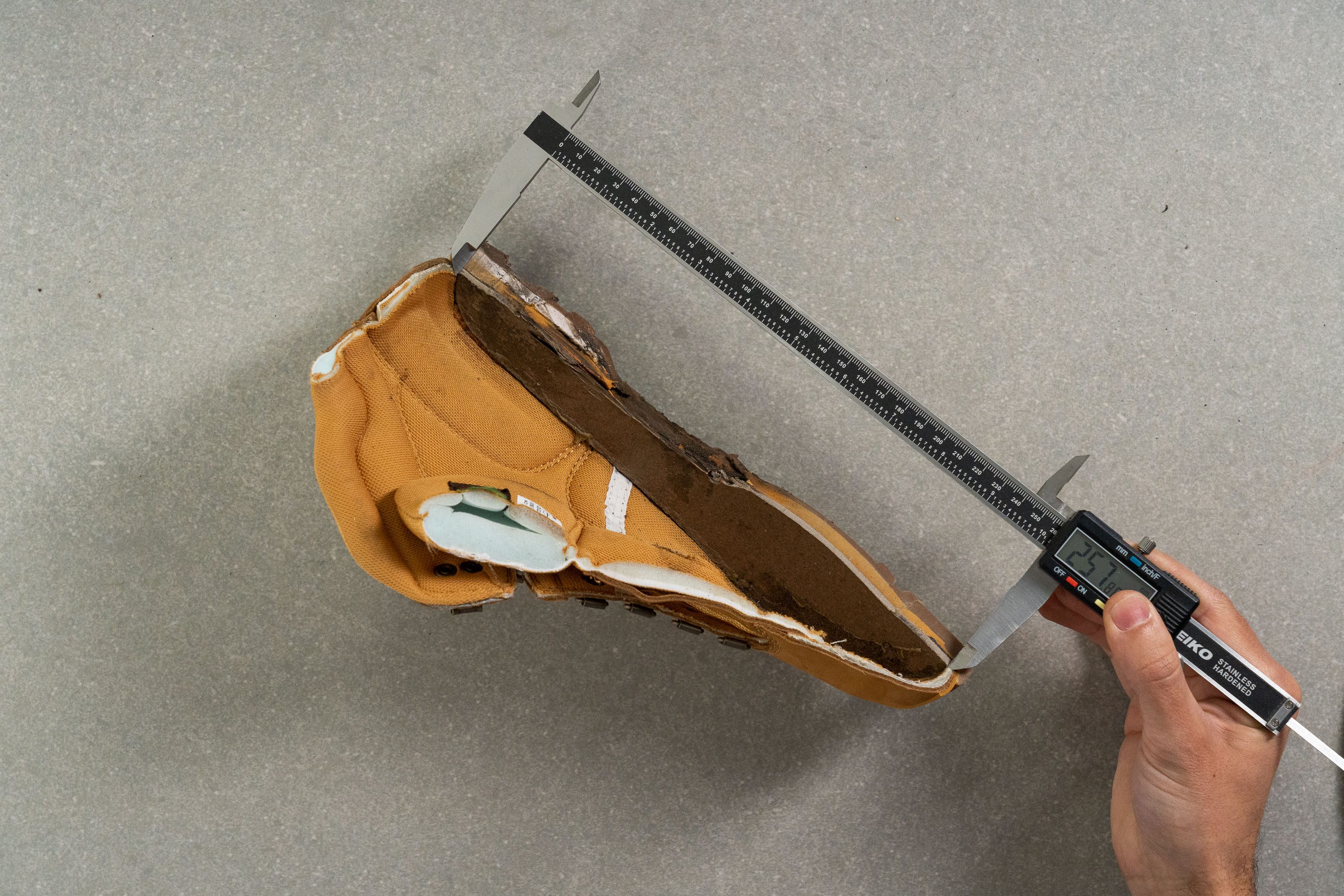
As for the toebox, we marked it as medium, based on our measurements. In its widest part, the toebox is 96.4 mm, a little narrower than the average 97.9 mm. It also gets narrower towards the big toe more than other hiking boots do (by 8%).
Thus, wide footers should consider getting the wide option in the Timberland Euro Hiker.
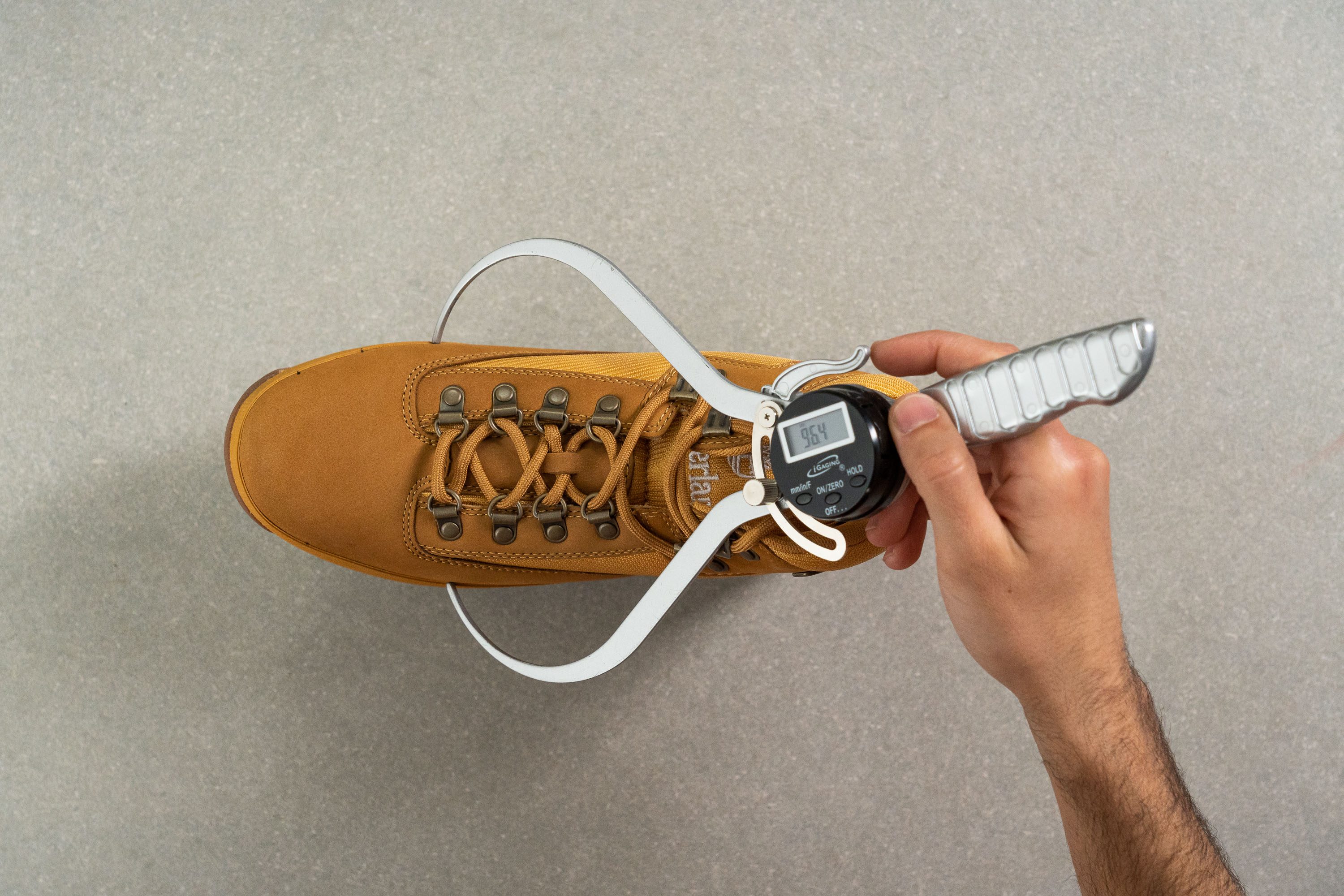
Effortless lacing
This Timberland boot comes with thick and hard-wearing rounded laces. Unfortunately, we did have issues with the length of the laces as well as with the fact that they got untied often.
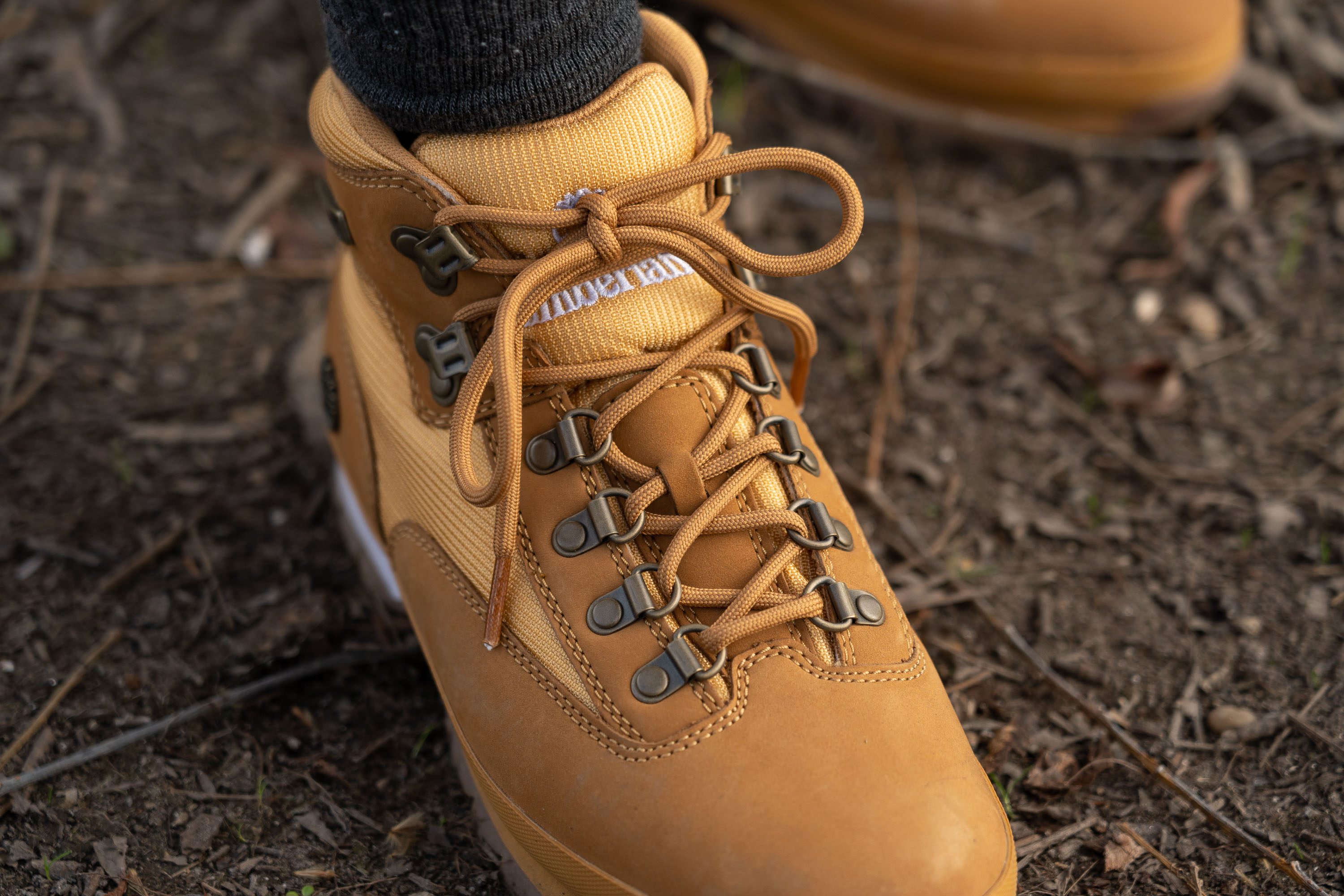
Two pairs of lace hoops are added at the top to help an easier on-and-off action.

Euro Hiker: A real value for money
With an MSRP of $110, the Timberland Euro Hiker is an absolute steal. Couple that with the boot's incredible durability, and you have for yourself a doozy of a trail kick!
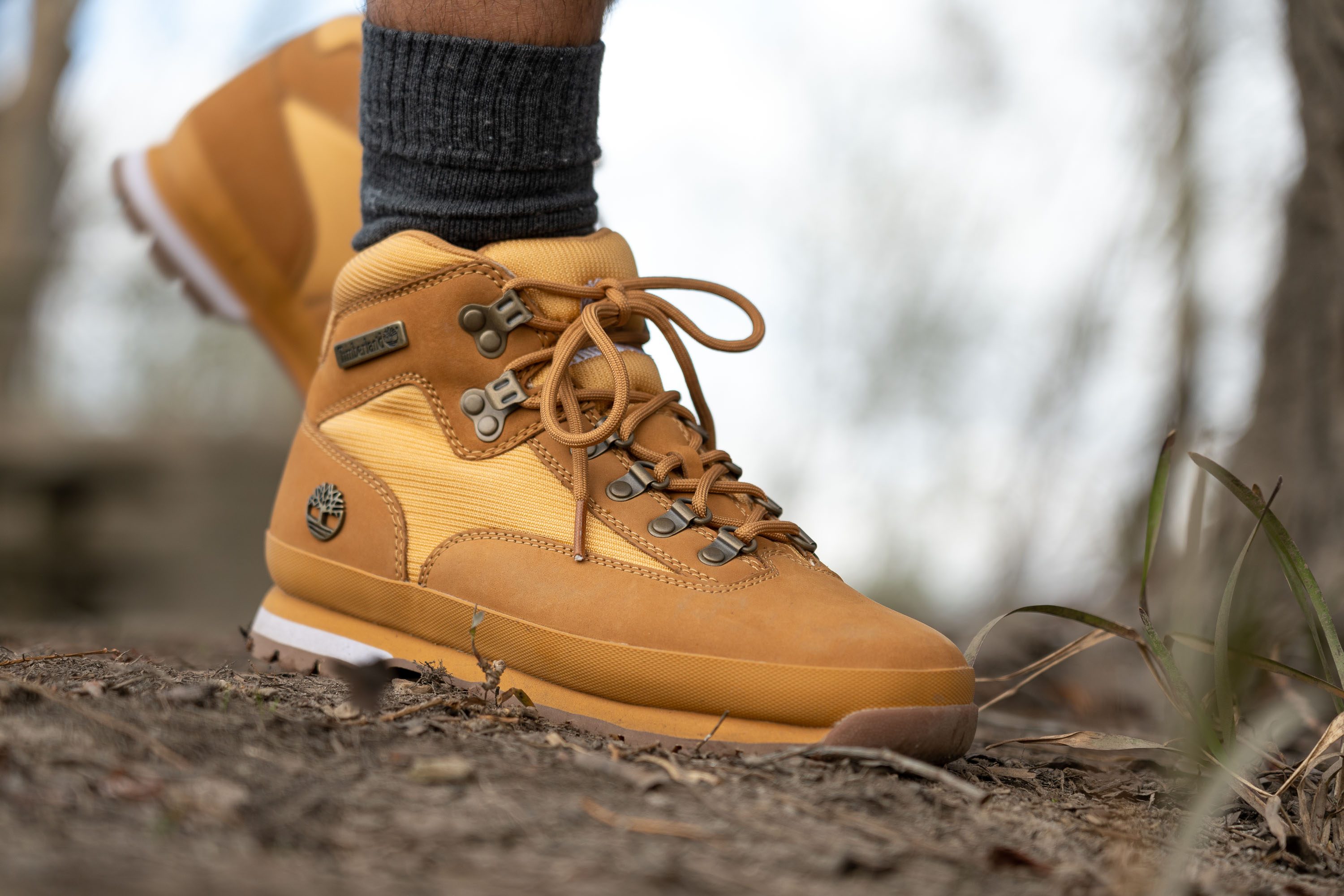
Other variations of the Timberland Euro Hiker
The Euro Hiker has been released for decades and the brand made sure to broaden its range for its iconic silhouette.
Euro Hiker Cordura Fabric
There's also a leather-less Euro Hiker, called Euro Hiker Cordura Fabric. Its upper is purely made of Cordura, a specific kind of textile that's twice as durable as standard nylon. It is resistant to punctures, scuffs, and tears.
Classic Leather Euro Hiker
The Classic Leather Euro Hiker boot is the premium, full-grain leather version of this footgear. Since its outer coverage is devoid of any sort of fabric, this variant has a more classic and rugged look to it. Its laces are also made from 100% recycled plastic bottles.
Jacquard Euro Hiker
For those looking for a lightweight Euro Hiker, try the one with the upper made of 100% polyester jacquard (a.k.a. the Jacquard Euro Hiker). It comes with an Ortholite insole, which deals with moisture (due to sweat) and stink. This variant also delivers enhanced breathability.
